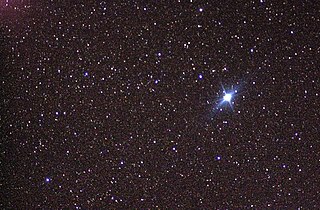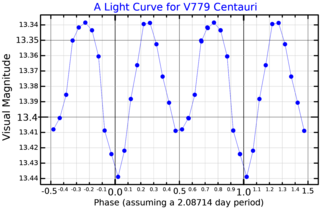
Physical cosmology is a branch of cosmology concerned with the study of cosmological models. A cosmological model, or simply cosmology, provides a description of the largest-scale structures and dynamics of the universe and allows study of fundamental questions about its origin, structure, evolution, and ultimate fate. Cosmology as a science originated with the Copernican principle, which implies that celestial bodies obey identical physical laws to those on Earth, and Newtonian mechanics, which first allowed those physical laws to be understood.

Olbers's paradox, also known as the dark night paradox, is an argument in astrophysics and physical cosmology that says that the darkness of the night sky conflicts with the assumption of an infinite and eternal static universe. In the hypothetical case that the universe is static, homogeneous at a large scale, and populated by an infinite number of stars, any line of sight from Earth must end at the surface of a star and hence the night sky should be completely illuminated and very bright. This contradicts the observed darkness and non-uniformity of the night sky.

Sirius is the brightest star in the night sky. Its name is derived from the Greek word Σείριος, meaning lit. 'glowing' or 'scorching'. The star is designated α Canis Majoris, Latinized to Alpha Canis Majoris, and abbreviated α CMa or Alpha CMa. With a visual apparent magnitude of −1.46, Sirius is almost twice as bright as Canopus, the next brightest star. Sirius is a binary star consisting of a main-sequence star of spectral type A0 or A1, termed Sirius A, and a faint white dwarf companion of spectral type DA2, termed Sirius B. The distance between the two varies between 8.2 and 31.5 astronomical units as they orbit every 50 years.

Star formation is the process by which dense regions within molecular clouds in interstellar space, sometimes referred to as "stellar nurseries" or "star-forming regions", collapse and form stars. As a branch of astronomy, star formation includes the study of the interstellar medium (ISM) and giant molecular clouds (GMC) as precursors to the star formation process, and the study of protostars and young stellar objects as its immediate products. It is closely related to planet formation, another branch of astronomy. Star formation theory, as well as accounting for the formation of a single star, must also account for the statistics of binary stars and the initial mass function. Most stars do not form in isolation but as part of a group of stars referred as star clusters or stellar associations.
Nucleosynthesis is the process that creates new atomic nuclei from pre-existing nucleons and nuclei. According to current theories, the first nuclei were formed a few minutes after the Big Bang, through nuclear reactions in a process called Big Bang nucleosynthesis. After about 20 minutes, the universe had expanded and cooled to a point at which these high-energy collisions among nucleons ended, so only the fastest and simplest reactions occurred, leaving our universe containing hydrogen and helium. The rest is traces of other elements such as lithium and the hydrogen isotope deuterium. Nucleosynthesis in stars and their explosions later produced the variety of elements and isotopes that we have today, in a process called cosmic chemical evolution. The amounts of total mass in elements heavier than hydrogen and helium remains small, so that the universe still has approximately the same composition.

Astronomy is a natural science that studies celestial objects and the phenomena that occur in the cosmos. It uses mathematics, physics, and chemistry in order to explain their origin and their overall evolution. Objects of interest include planets, moons, stars, nebulae, galaxies, meteoroids, asteroids, and comets. Relevant phenomena include supernova explosions, gamma ray bursts, quasars, blazars, pulsars, and cosmic microwave background radiation. More generally, astronomy studies everything that originates beyond Earth's atmosphere. Cosmology is a branch of astronomy that studies the universe as a whole.

A supermassive black hole is the largest type of black hole, with its mass being on the order of hundreds of thousands, or millions to billions, of times the mass of the Sun (M☉). Black holes are a class of astronomical objects that have undergone gravitational collapse, leaving behind spheroidal regions of space from which nothing can escape, not even light. Observational evidence indicates that almost every large galaxy has a supermassive black hole at its center. For example, the Milky Way galaxy has a supermassive black hole at its center, corresponding to the radio source Sagittarius A*. Accretion of interstellar gas onto supermassive black holes is the process responsible for powering active galactic nuclei (AGNs) and quasars.

The Nommo or Nummo are primordial ancestral spirits in Dogon religion and cosmogony venerated by the Dogon people of Mali. The word Nommos is derived from a Dogon word meaning "to make one drink." Nommos are usually described as amphibious, hermaphroditic, fish-like creatures. Folk art depictions of Nommos show creatures with humanoid upper torsos, legs/feet, and a fish-like lower torso and tail. Nommos are also referred to as "Masters of the Water", "the Monitors", and "the Teachers". Nommo can be a proper name of an individual or can refer to the group of spirits as a whole. For purposes of this article, "Nommo" refers to a specific individual and "Nommos" is used to reference the group of beings.

Canopus is the brightest star in the southern constellation of Carina and the second-brightest star in the night sky. It is also designated α Carinae, which is romanized (transliterated) to Alpha Carinae. With a visual apparent magnitude of −0.74, it is outshone only by Sirius.

Beta Canis Majoris, also named Mirzam, is a star in the southern constellation of Canis Major, the "Great Dog", located at a distance of about 500 light-years (150 parsecs) from the Sun. In the modern constellation it lies at the position of the dog's front leg.

Centaurus X-3 is an X-ray pulsar with a period of 4.84 seconds. It was the first X-ray pulsar to be discovered, and the third X-ray source to be discovered in the constellation Centaurus. The system consists of a neutron star orbiting a massive, O-type supergiant star dubbed Krzeminski's star after its discoverer, Wojciech Krzemiński. Matter is being accreted from the star onto the neutron star, resulting in X-ray emission.

In astrophysics, accretion is the accumulation of particles into a massive object by gravitationally attracting more matter, typically gaseous matter, into an accretion disk. Most astronomical objects, such as galaxies, stars, and planets, are formed by accretion processes.

Cosmology is a branch of physics and metaphysics dealing with the nature of the universe, the cosmos. The term cosmology was first used in English in 1656 in Thomas Blount's Glossographia, and in 1731 taken up in Latin by German philosopher Christian Wolff, in Cosmologia Generalis. Religious or mythological cosmology is a body of beliefs based on mythological, religious, and esoteric literature and traditions of creation myths and eschatology. In the science of astronomy, cosmology is concerned with the study of the chronology of the universe.
Megrez, also called Delta Ursae Majoris, is a star in the northern constellation of Ursa Major. With an apparent magnitude of +3.3, it is the dimmest of the seven stars in the Big Dipper asterism. Parallax measurements yield a distance estimate of 80.5 light-years from the Sun.

A star chart is a celestial map of the night sky with astronomical objects laid out on a grid system. They are used to identify and locate constellations, stars, nebulae, galaxies, and planets. They have been used for human navigation since time immemorial. Note that a star chart differs from an astronomical catalog, which is a listing or tabulation of astronomical objects for a particular purpose. Tools using a star chart include the astrolabe and planisphere.

Jean-Pierre Luminet is a French astrophysicist, specializing in black holes and cosmology. He is an emeritus research director at the CNRS. Luminet is a member of the Laboratoire d'Astrophysique de Marseille (LAM) and Laboratoire Univers et Théories (LUTH) of the Paris-Meudon Observatory, and is a visiting scientist at the Centre de Physique Théorique (CPT) in Marseilles. He is also a writer and poet.

The Dunhuang map or Dunhuang Star map is one of the first known graphical representations of stars from ancient Chinese astronomy, dated to the Tang dynasty (618–907). Before this map, much of the star information mentioned in historical Chinese texts had been questioned. The map provides a graphical verification of the star observations, and are part of a series of pictures on one of the Dunhuang manuscripts. The astronomy behind the map is explained in an educational resource posted on the website of the International Dunhuang Project, where much of the research on the map has been done. The Dunhuang Star map is to date the world's oldest complete preserved star atlas.
Deuterium fusion, also called deuterium burning, is a nuclear fusion reaction that occurs in stars and some substellar objects, in which a deuterium nucleus and a proton combine to form a helium-3 nucleus. It occurs as the second stage of the proton–proton chain reaction, in which a deuterium nucleus formed from two protons fuses with another proton, but can also proceed from primordial deuterium.

David Elbaz is a French observational astrophysicist specializing in galaxy formation and evolution. He is Research Director at the Commissariat à l'Énergie Atomique et aux Énergies Alternatives (CEA-Saclay), where he has been a researcher in the Astrophysics Division (AIM) since 1994. There, he was in charge of directing the "Cosmology and Evolution of Galaxies" laboratory for about a decade. He has been the managing editor of the journal Astronomy & Astrophysics since 2018.
Thomas Lepeltier is a French independent scholar, essayist and science writer specializing in the history and philosophy of science and applied ethics, known in particular for his contributions to the field of animal law. He is the author of several philosophical works on animal ethics such as L'imposture intellectuelle des carnivores and of science history books including Darwin hérétique and Univers parallèles. Known initially as a science historian, he now mainly advocates in defense of animals in the French media.















